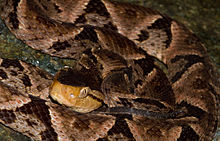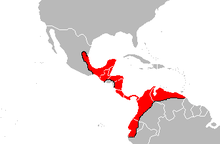
Back بوثروبس اسبر ARZ Bothrops asper Catalan Bothrops asper CEB Křovinář aksamitový Czech Terciopelo-Lanzenotter German Bothrops asper Spanish Bothrops asper Basque Keskiamerikankeihäskäärme Finnish Bothrops asper French Bothrops asper Galician
| Bothrops asper | |
|---|---|

| |
| Scientific classification | |
| Domain: | Eukaryota |
| Kingdom: | Animalia |
| Phylum: | Chordata |
| Class: | Reptilia |
| Order: | Squamata |
| Suborder: | Serpentes |
| Family: | Viperidae |
| Genus: | Bothrops |
| Species: | B. asper
|
| Binomial name | |
| Bothrops asper (Garman, 1884)
| |

| |
| Geographical range of Bothrops asper. | |
| Synonyms | |
|
List
| |
The terciopelo (Bothrops asper)[note 1] is a species of pit vipers, found in Central to South Americas. At low to moderate elevations, its habitat ranges from northeastern Mexico to Colombian and Ecuadorian Andes, as well as Venezuela.[3] With a mass of up to 6 kilograms (13 lb), and a maximal length of 2.5 metres (8.2 ft), the terciopelo is among the largest vipers. It is light to dark brown in color, often with yellowish, zig-zag patterning on either side of its body. Dubbed "the ultimate pit-viper" for its defensiveness, large size, fangs and potent venom yield, it has a fearsome reputation, responsible for the most envenomated snakebites within its range, largely due to its proximity to humans, livestock and pets.[2] Nonetheless, like all venomous snakes, the terciopelo actively avoids contact with humans and larger animals, with bites generally only occurring when the snake is cornered, pursued, or threatened. No subspecies are currently recognized.[6]
- ^ Bonilla, F., Sunyer, J., Porras, L.W., Chaves, G., Lamar, W., Solórzano, A., Rivas, G., Caicedo, J.R., Gutiérrez-Cárdenas, P. & Cisneros-Heredia, D.F. 2021. Bothrops asper. The IUCN Red List of Threatened Species 2021: e.T197464A2486766. https://dx.doi.org/10.2305/IUCN.UK.2021-3.RLTS.T197464A2486766.en. Accessed on 16 January 2023.
- ^ a b McDiarmid RW, Campbell JA, Touré T. 1999. Snake Species of the World: A Taxonomic and Geographic Reference, vol. 1. Herpetologists' League. 511 pp. ISBN 1-893777-00-6 (series). ISBN 1-893777-01-4 (volume).
- ^ a b Campbell; Lamar, Jonathan; William (2004). The Venomous Reptiles of the Western Hemisphere. Ithaca and London: Comstock Publishing Associates. p. 870. ISBN 0-8014-4141-2.
{{cite book}}: CS1 maint: multiple names: authors list (link) - ^ Liner, Ernest A. (1994). Scientific and common names for the amphibians and reptiles of Mexico in English and Spanish. Herpetological Circular No. 23. Society for the Study Amphibians and Reptiles. i-iii, 1-113 pp. ISBN 0-916984-32-X
- ^ Liner, Ernest A. and Gustavo Cass-Andreu. (2008). Standard Spanish, English and Scientific Names of the Amphibians and Reptiles of Mexico (2nd. ed.). Herpetological Circular No. 38. Society for the Study of Amphibians and Reptiles. iv, 162 pp. ISBN 978-0-916984-75-5
- ^ "Bothrops asper". Integrated Taxonomic Information System. Retrieved 6 November 2006.
Cite error: There are <ref group=note> tags on this page, but the references will not show without a {{reflist|group=note}} template (see the help page).
© MMXXIII Rich X Search. We shall prevail. All rights reserved. Rich X Search
